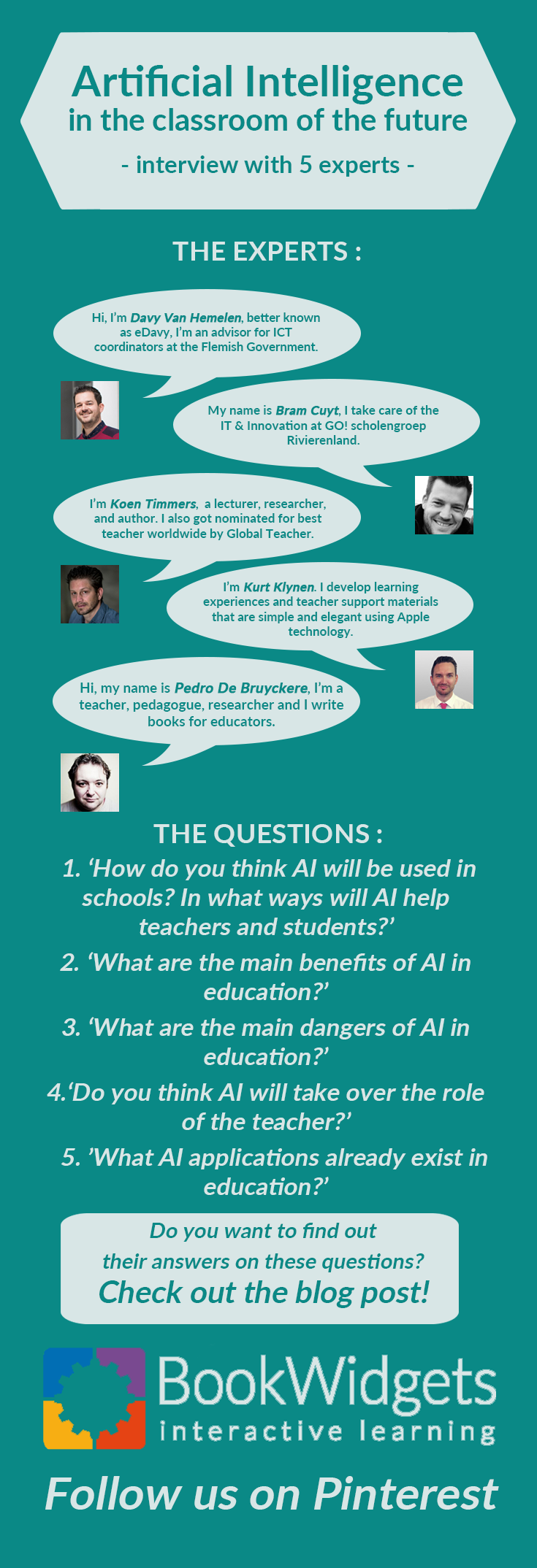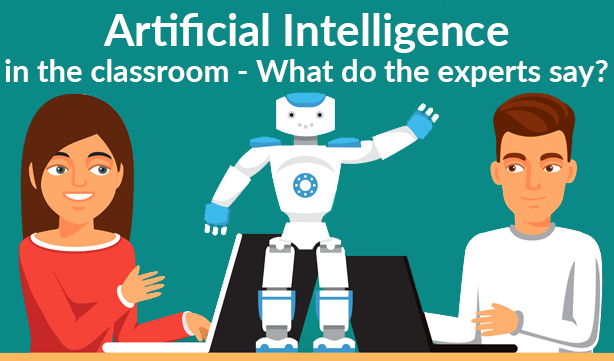Artificial intelligence in the classroom - What do the experts say?
 Karel Jansen —
Karel Jansen —
Artificial Intelligence (or AI for short) is increasingly finding its way into our lives. More and more, we wonder how our future is going to change with technology becoming smarter every day.
As an educational blogger, I’m particularly interested how AI is going to change our lives as teachers as well: how can this technology be implemented in education? how will it affect our future classroom? Or, an even bigger question: will it take over the place of a teacher? I popped these questions to a panel of educational experts. Let’s hear them out!
What do the experts say about AI?
I asked 5 educational and IT experts about their view on AI in the classroom of the future.
 Davy Van Hemelen, better known as eDavy and educational technology advisor at the Flemish Government.
Davy Van Hemelen, better known as eDavy and educational technology advisor at the Flemish Government.
 Kurt Klynen, developer of learning experiences and teacher support materials that are simple and elegant using Apple technology, tools, and apps to improve engagement and outcomes.
Kurt Klynen, developer of learning experiences and teacher support materials that are simple and elegant using Apple technology, tools, and apps to improve engagement and outcomes.
 Pedro De Bruyckere, teacher, pedagogue, researcher and author in the educational field.
Pedro De Bruyckere, teacher, pedagogue, researcher and author in the educational field.
 Koen Timmers, lecturer, researcher, author, and 2018 top 10 nominee for best teacher worldwide by Global Teacher Prize.
Koen Timmers, lecturer, researcher, author, and 2018 top 10 nominee for best teacher worldwide by Global Teacher Prize.
 Bram Cuyt, IT & Innovation manager at multiple schools in Belgium.
Bram Cuyt, IT & Innovation manager at multiple schools in Belgium.
Let’s get their point of view on my (and probably yours as well) questions about AI in education.
Question 1: How do you think AI will be used in schools? In what ways will AI help teachers and students?
Koen: Remember that trip to Italy with a classic map? That same trip runs a lot more smoothly thanks to Waze or Google maps, which accurately indicate how long it will take you to reach your goal, taking into account traffic jams and other factors. AI can mean the same for education. However, you first have to make an important distinction between technology for teachers and technology for students, and categorise technologies.
Technology helps to better visualize abstract concepts, can promote collaborative learning, provide quick and objective feedback, support and partially replace a teacher. AI can strengthen a teacher, personalise education or boost learning outcomes. I made a chatbot that my students can consult 24/7. This gives me more time for in-depth questions as a teacher. But the chatbot will never replace me. At the university college of PXL, we also developed learning analyticsthat indicate whether a student is likely to succeed or not. This one has a 75% accuracy. This creates new situations where the teacher has to learn to handle things smartly.
Pedro: There is a great deal in what is soon to be called virtual tutors. IBM converted its Watson computer to such applications, and Flemish Community Education also announced such a project in which students receive personalized feedback and further challenges, or in which teachers receive suggestions as to which questions they should ask which student or which students should be given extra support. In a research project, we ourselves have already experimented with machine learning to assess papers, even if we are only at the beginning of the project.
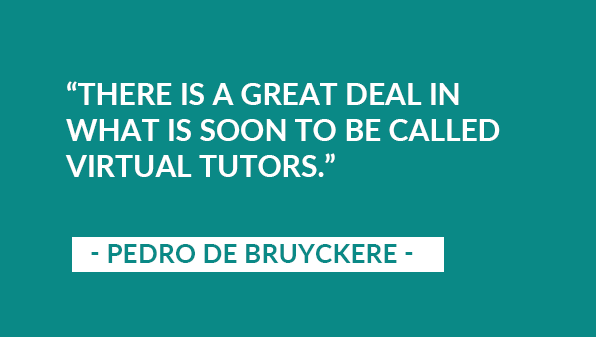
Davy: AI will take a lot of work away from the teacher, especially repetitive tasks. More automatic improvements will be made. It will be possible to automatically generate tests and worksheets based on a course. The student will also be able to ask the AI questions, get useful answers, and thus follow an adapted individual learning path that the teacher can also follow in a data dashboard. The AI will not only advise the student, but will also be able to provide the teacher with useful data and advise on where, for example, there are unclear parts in the course.
Question 2: What are the main benefits of AI in education?
Bram: Simplify and automate where possible, respond more quickly to the moment, provide better tailored support, and this for all learners. But certainly also for the learning stimulators (teachers). Rapid analysis of data can also give them the advantage of being warned more quickly, or being able to carry out tasks more efficiently.
Davy: Teachers will have more time to really be in front of the class and guide their students. Students will also have 24/7 access to a tool to follow their individual and adapted learning process. This is ideal to really differentiate in order to challenge the strong students and help the weaker students better. You don’t have to come to school to take lessons either. Thanks to the AI teacher, we will all have a platform to follow the lessons at home. Moreover, an AI cannot prejudge a student and everyone will be treated equally.
Kurt: Speed and computing power. We can already see the first results of this. I think of simultaneous translations, interpreters for the hearing impaired and the deaf, and subtitles in different languages. Hopefully, this will help you with teaching in front of a classroom with 25 different nationalities and languages.
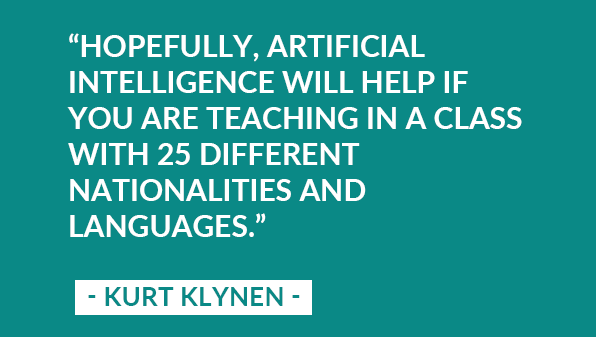
Question 3: What are the main dangers of AI in education?
Pedro: The dangers and benefits are sometimes close to each other. Personalization is often mentioned as an advantage, and any support for differentiation is welcome, but the few examples where personalization created greater inequality is an important point of attention. In addition to the usual concerns about privacy, we also have to be careful of the biases that we increasingly see appear in algorithms. Perhaps the greatest danger at the moment is that expectations are too high. Testimonials from the sector of providers of such applications indicate that we are not ready yet if the subject matter becomes a little more complex, and predict that this will take a long time.
Bram: Too high expectations, and the idea that computers will completely take over human tasks. We have to be media-savvy about screen time and be aware that learning cannot and will not only take place in front of a computer. Students must be able to write in order to process material, physically cooperate and deal creatively with all kinds of materials. We can never and will never replace the teacher with a smart laptop or tablet.
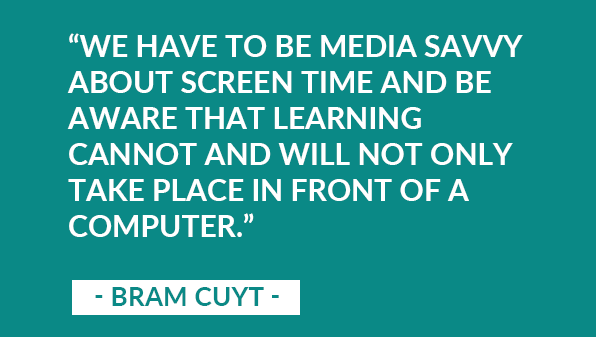
Question 4: Do you think AI will take over the role of the teacher?
Kurt: As with any introduction of new technology, there is a fear of losing your profession, your craft. For me, no technology can replace a good teacher. AI can be a useful assistant for the teacher’s growing range of tasks, so we can focus on teaching again. In other words, as a teacher, we need to be aware of the possibilities of AI and know how to guide our students in a world where AI will be all around them.
Davy: No, the focus of the teacher of the future will undoubtedly be less on expertise or certain knowledge, but more as a supervisor in the learning process. Some more practical or care directions will need more real teachers and less pure knowledge experts. The artificial intelligent computer teacher will eventually be able to possess much more knowledge than a human teacher and will, of course, be able to answer questions. This computer will also be available to the learner 24/7, but a human teacher will still need to manage the classroom environment, motivate learners, as well as learn socio-emotional skills. A daily class day will no longer look like it does today.
Koen: Intuitively I would say no, but it strikes me that people apparently can’t cope with looking far into the future. With the exception of a few visionaries, the future is typically said to be the same as it will be in four generations to come. However, I hope that there will still be life in the year 4000. And when you see what progress has been made during the last century, it is unbelievable. It is impossible to predict what technology will be able to do in the future.
Maybe machines will become empathic and link the right didactics to certain lesson topics. But the question is whether people want this. MacDonalds is already able to have restaurants running 100% mechanically. However, they made a turnaround by deploying people again, because customers find it more pleasant. There is also the uncanny valley. People think a robot is okay up to a certain point; the more they look like people they find even better. But there is a certain threshold where robots look too much like people. This is the uncanny valley. This is where people are totally refurbished. I think that will be the case in education. Students are always going to choose human teachers. Technology and AI can strengthen the teacher.
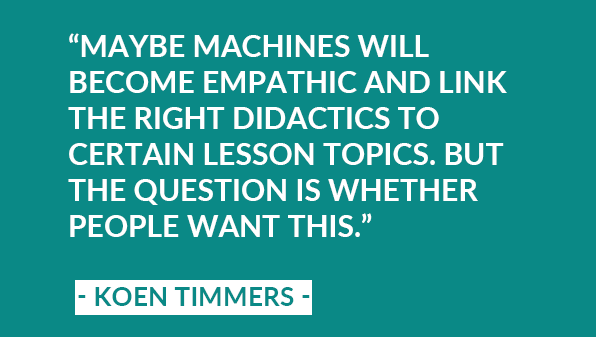
Question 5: What AI applications already exist in education?
Davy: Artificial intelligence is already entering the school in all kinds of subtle tools and programs. Just think of the way Google Forms already fills in possible answers to questions when you formulate a question for a test. Some programs already translate other languages live into a conversation between two people. The need to learn a foreign language will, therefore, be less necessary in the future because of AI. Furthermore, AI is still in its infancy, but it is really taking big leaps and bounds, and the potential is already clearly present.
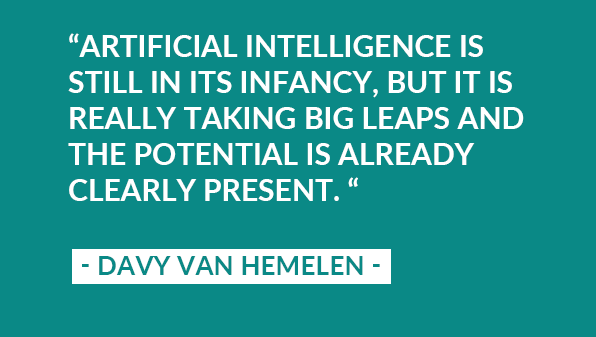
Bram: AI still has a lot to prove in education and the world around it. There are already many initiatives that automate the testing of subjects, and even include a first form of classification or remediation. But often, these systems are not flexible enough, or the subject matter is “locked-in” and only offered by one publisher. A recent initiative of the Flemish Public Schools approaches AI, in my opinion, in a much broader way. The advantage of this project is that educational strategies (didactics, class organisation, personalised learning, …) and technology (AI that fills the learning process and reduces the planning burden) are a good match to make personalized education possible for all learners on the basis of expertise from education, computer and neuroscience.
Kurt: Sway from Microsoft is a good example. This design tool lets students focus on the content they put in, while AI is working in the background to alter the design of their work. Brainly is another website where students can ask questions about all kind of subjects with the help of AI. Another fun tool is “Pixar in a Box”, a collaboration between Pixar and Khan Academy that shows students how Pixar artists do their jobs. The subjects students learn in school are used every day to create amazing movies at Pixar.
Conclusion
AI could have a huge grip on education. Although it can already help teachers out today, it will bring more and more support in the future, allowing teachers to focus more on students, which is good for both students and teachers.
What do you think? Do you see AI as something positive or rather as something negative? Let us know via @ibookwidgets and Tweet about it.
